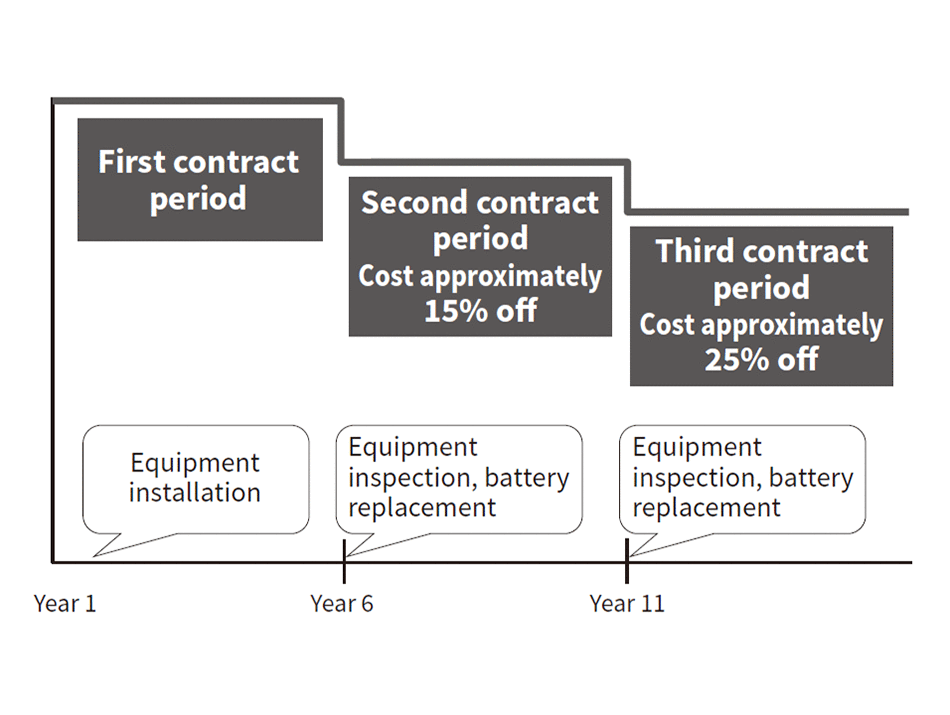Core Utility Products Underpinning the Social InfrastructureConnected Uninterruptible Power Systems Featuring Scalability and Reliability
Highlight
An uninterruptible power supply system is a key device that plays a crucial role in eliminating power failures in the equipment that underpins the social infrastructure. When creating a power system with an uninterruptible power supply, the optimum system needs to be constructed to satisfy a wide range of user needs such as load management and facility size, maintainability, scalability, and cost-effectiveness. Hitachi has an extensive uninterruptible power supply system lineup and provides power systems that feature high power supply continuity, reliability, and scalability. In 2018, Hitachi released a new lineup of small uninterruptible power supply models that enable faster response when failures are discovered. The company has started providing a new Internet of Things based maintenance service for these models that lets users enjoy continuous worry-free use of their uninterruptible power supply.
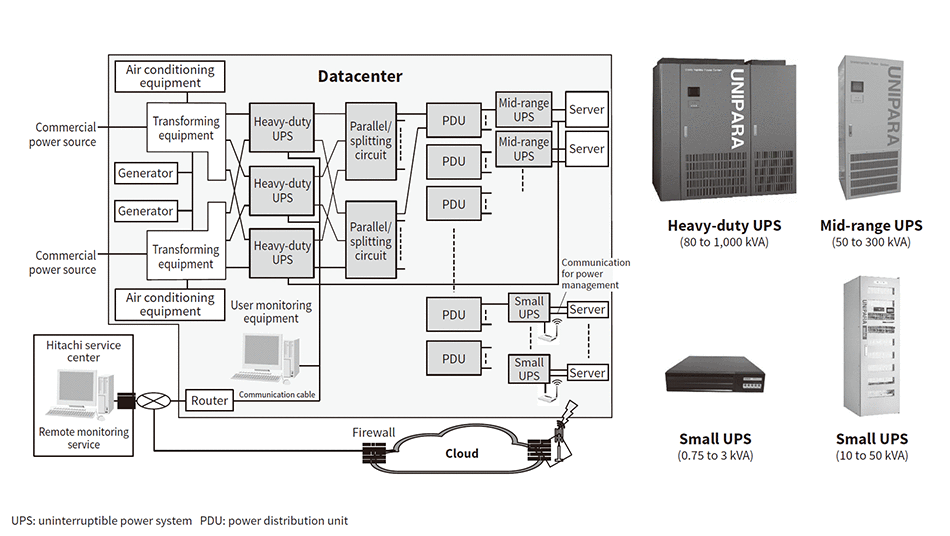
1. Introduction
Recent advances in digitalization are creating a transformation to an Internet of things (IoT) era in which network connectivity encompasses not only the information and communication systems of the information society, but also the factory automation equipment and sensors used in factories. Uninterruptible power systems (UPS systems) are growing in importance for their role in assisting the stable operation of this equipment.
Along with high power supply reliability and power conversion efficiency, a UPS used in the power system of a large datacenter also needs to provide the high scalability needed to enable easy UPS upgrading in the existing system to handle rising loads as equipment or other needs expand (see Figure 1). A UPS used with factory automation equipment or with small equipment such as PCs or communication devices also needs to combine high reliability with a space-saving design that can be installed in limited surface area.
Hitachi has responded to the growing importance of UPS systems by creating an extensive lineup of UPS models that have output capacities ranging from 0.75 to 1,000 kVA per unit to meet a wide range of needs. The company also provides maintenance services that let users measure UPS operation states and storage battery degradation levels, and feature remote monitoring from Hitachi service centers. Hitachi’s small UPS models can be coupled to a server to provide power management functions that help save labor when managing operations. For the new lineup of small UPS models(1), Hitachi has started to provide monitoring services that enable rapid support by using the IoT for online cloud-based storage of data such as UPS and storage battery operating state/maintenance information. This article looks at the connected UPS systems that are assisting the next-generation manufacturing(2) of the Hitachi.
Fig. 1—Datacenter UPS Configuration Example Selecting from among a product lineup that includes heavy-duty, mid-range, and small UPS models enables configuration of UPS systems optimized for various equipment styles and applications.
Selecting from among a product lineup that includes heavy-duty, mid-range, and small UPS models enables configuration of UPS systems optimized for various equipment styles and applications.
2. Meeting the Needs of UPS Power System Users
2.1 Using Redundant Systems to Improve Reliability
Fig. 2—Parallel Redundant System Configuration Example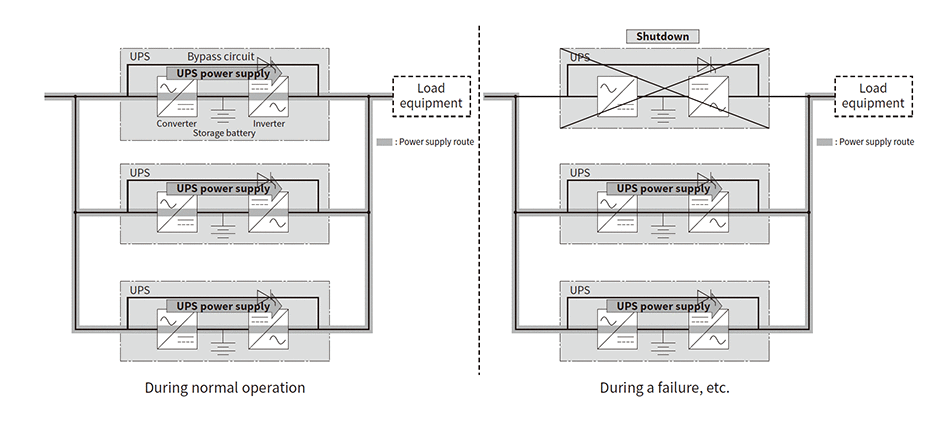 Multiple UPS units are connected in parallel to make the total UPS output capacity greater than the power used by the load equipment, enabling the UPS power supply to continue from the remaining functioning UPS units when a UPS unit shuts down due to failure, etc.
Multiple UPS units are connected in parallel to make the total UPS output capacity greater than the power used by the load equipment, enabling the UPS power supply to continue from the remaining functioning UPS units when a UPS unit shuts down due to failure, etc.
Fig. 3—Standby Redundant System Configuration Example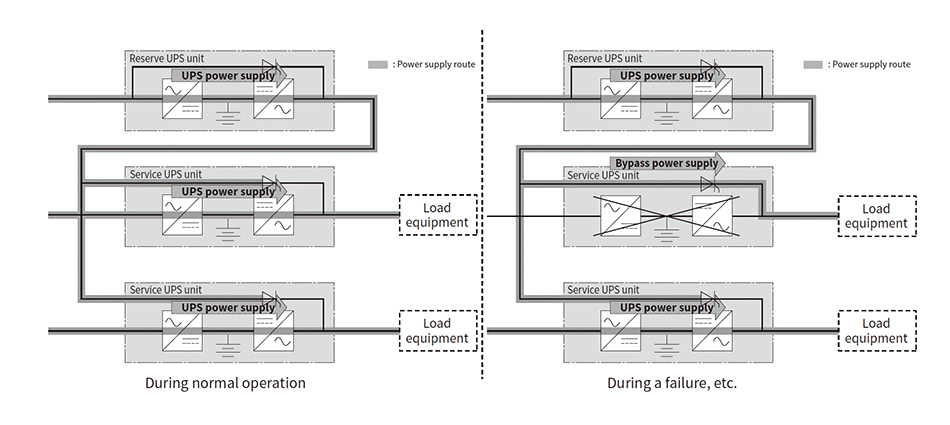 The reserve UPS unit supplies power to the bypass circuits of the service UPS units, enabling uninterrupted UPS power supply from the reserve UPS unit to the load equipment if any service UPS unit switches to bypass power supply due to a failure, etc.
The reserve UPS unit supplies power to the bypass circuits of the service UPS units, enabling uninterrupted UPS power supply from the reserve UPS unit to the load equipment if any service UPS unit switches to bypass power supply due to a failure, etc.
The rapid rise of the digital age in recent years has seen power capacities expanding to meet the needs of ever-larger datacenters, and growing demand for large UPS systems(3). Since shutdowns of the power supply to the equipment could have untold consequences, these systems need to increase reliability both by installing a UPS in the power equipment and by using multiple UPS units to create power system redundancy. Typical system configuration examples include parallel redundant systems and standby redundant systems(4).
Figure 2 shows an example of a parallel redundant system configuration. Multiple identical UPS units are connected in parallel to a common output bus. The total UPS output capacity is higher than the load capacity, ensuring redundancy since the remaining functional UPS units can continue supplying power if one UPS unit shuts down due to a failure or equipment problem. Hitachi’s series of mid-range and heavy-duty UPS models are top-selling products that use a parallel configuration*1. When creating a parallel redundant system, they eliminate the need for a common control unit. They are configured with an independent control unit provided for each UPS unit, preventing effects from the other UPS units. This type of configuration enables high-continuity power supply and scalability by providing hot-swappable UPS units in which the individual power supplies connected in parallel can go in and out of service without interrupting the supply of power. There is no need to switch to the commercial power source’s bypass power supply when maintaining, inspecting, or scaling out the UPS units.
A standby redundant system is configured from service UPS units that continuously supply power to the load, and a reserve UPS unit that supplies power to the bypass circuits of the service UPS units during routine operation (see Figure 3). This method creates an uninterrupted power supply and ensures redundancy by supplying power from the reserve UPS unit via the bypass circuit of any service UPS unit that switches to its bypass circuit due to equipment problems, etc. Hitachi’s mid-range and heavy-duty UPS models can support both parallel redundant systems and standby redundant systems as needed to adapt to user load management and conditions such as cost-effectiveness and maintainability.
- *1
- A method of configuring a parallel system from parallel connection of UPS units with built-in bypass circuits.
2.2 Longer Life and More Space-saving Designs
The storage batteries used in UPS systems need to have high storage capacities, so lead-acid batteries are widely used for their relatively low cost. But, lead-acid batteries need to be replaced every 5 to 10 years as their capacity decreases with aging, so lifecycle costs will include the cost of replacing storage batteries. Hitachi’s new series of small UPS models addresses this issue by supporting long-life lithium-ion batteries, which have a 15-year life expectancy (at an ambient temperature of 25°C). For a 15-year lifecycle, the need to replace storage batteries has been eliminated. Lithium-ion batteries also have higher energy density than lead-acid batteries, enabling installation in about 40% less space*2 than conventional models (for a 30-kVA model with a 10-minute power failure compensation time).
- *2
- Value calculated by Hitachi Industrial Products, Ltd. in comparison to a long-life MSE storage battery.
3. IoT-based Operation Management/Maintenance Solutions
3.1 Support for Automated Power Source Management
Fig. 4—Automation and Scheduled Operation by Power Management Software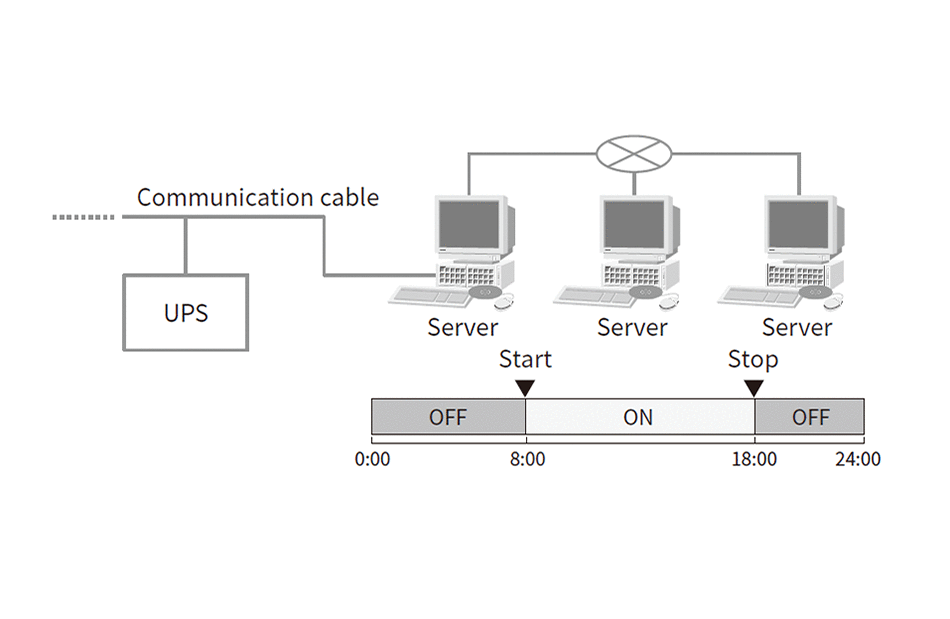 Using dedicated software in servers enables servers to shut down when power failures arise. The software also enables scheduled operation that automatically starts/stops the UPS remotely.
Using dedicated software in servers enables servers to shut down when power failures arise. The software also enables scheduled operation that automatically starts/stops the UPS remotely.
When a power failure occurs in a facility that has a small UPS in a single-unit system*3, the load-bearing servers and computers need to be shut down safely while the UPS continues to supply power. But, datacenters containing a large number of small UPS units need labor-saving server shutdown operations. By using dedicated power management software, Hitachi’s small UPS models have a function that sends a shutdown signal to the server during a power failure. To shut down the load at night, on holidays, or at similar times, some facilities demand scheduled operation that supplies UPS power only at times determined by the time slot and day of the week. The power management software can also be set to perform this type of scheduled UPS operation (see Figure 4).
- *3
- A system that supplies power to the load using a single UPS unit.
3.2 Monitoring Services/Lease Service with a Fixed Monthly Fee
Maintaining the reliability of UPS systems requires periodic maintenance and ongoing monitoring after operation has started. To meet these needs, Hitachi’s UPS systems have an added communication interface that enables remote monitoring of UPS operation states, equipment problems, and the like. The dedicated software lets the user monitor the system in-house, and an optional online maintenance support service is also available for systems connected online (on a public line) enabling automatic reporting to the Hitachi service center. The service is a 24-hours-a-day monitoring system that can provide rapid response when problems occur. The storage battery is one key component of a UPS system. Since the length of a storage battery’s life is highly dependent on operating environment conditions such as ambient temperature, measuring each battery’s voltage and internal resistance levels to monitor its degradation level is an effective way to make further gains in reliability. Monitoring equipment can be connected to storage batteries to provide the same dedicated software-based monitoring and online support services available for Hitachi’s UPS systems.
Hitachi provides a new IoT-based maintenance solution (monitoring service) for the new series of small UPS models. Figure 5 shows the monitoring service system configuration. The small UPS system is connected by mobile communication from a wireless device to a Hitachi service center via an online cloud. The system provides the same maintenance services as conventional online maintenance support services, while also storing operation history data at the service center such as load factor, ambient temperature, and storage battery states. This operation state data can be viewed online from the user’s PC on a dedicated portal site. The site enables communication between the user and Hitachi, providing news and responses to inquiries. It also includes a document management service that provides access to information such as equipment delivery documents, delivered equipment specifications, and part replacement histories. It can be used for medium- to long-term equipment operation management and maintenance work plans for load upgrading, storage battery replacement scheduling, etc. (see Figure 6). Storing and analyzing their operation histories could help service users determine the proper timing for proposing maintenance or upgrades.
Hitachi has created a lease service with a fixed monthly fee for its new series of small UPS models. Provided under a 5-year contract, the service includes the UPS hardware, storage battery, and other parts replacement, and operation management and maintenance services (monitoring services for routine monitoring and failure handling) (see Figure 7). The service lets users install a UPS system without startup costs, while flexibly adapting to changes in the business environment or technology trends by reviewing the contract every 5 years. The operation management and maintenance provided with the service should also make UPS installation easy for users in industries that are still unfamiliar with UPS use.
Fig. 5—Monitoring Service Configuration UPS state and monitoring data is stored via the cloud. The user can view monitoring data in-house, and rapid maintenance support can be provided by a Hitachi service center that monitors UPS states 24 hours a day.
UPS state and monitoring data is stored via the cloud. The user can view monitoring data in-house, and rapid maintenance support can be provided by a Hitachi service center that monitors UPS states 24 hours a day.
Fig. 6—Portal Site Screen Example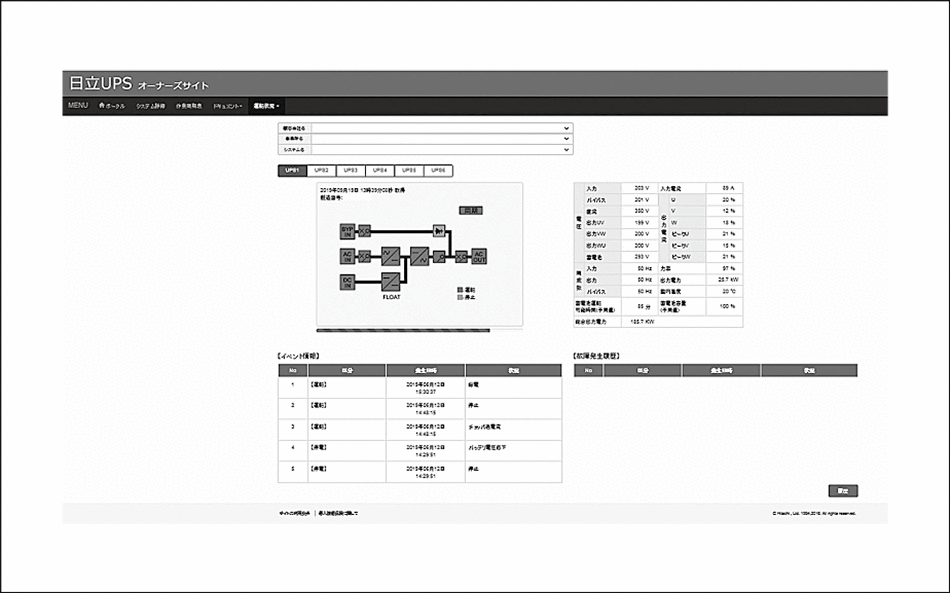 The portal site gives the user 24-hours-a-day access to information such as delivery histories, operation states, and delivery drawings. The Hitachi service center can also access this information, enabling it to provide information such as part replacement dates in a timely manner.
The portal site gives the user 24-hours-a-day access to information such as delivery histories, operation states, and delivery drawings. The Hitachi service center can also access this information, enabling it to provide information such as part replacement dates in a timely manner.
4. Conclusions
This article has presented Hitachi UPS models that satisfy the need for the high reliability, scalability, and space-saving designs that UPS systems require, and has presented the IoT-based services Hitachi has started providing to improve reliability and ensure user safety and convenience. The monitoring services currently offered for the new series of small UPS models will be augmented in the future to support a greater range of UPS models including heavy-duty types.
REFERENCES
- 1)
- Hitachi News Release, “Hitachi Commences Sales of Energy-saving/Small UPS,” (Mar. 2018), in Japanese.
- 2)
- Hitachi IR Day 2019, Industry Sector, p. 12 (Jun. 2019). (PDF Format, 2.8MB)
- 3)
- K. Kawahata et al., “Latest Trends and Various Developments of Internet Datacenter (2) —Constructing Highly Reliable, Energy-saving Large-capacity UPS—,” the 26th Conference of the Institute of Electrical Installation Engineers of Japan (Sep. 2008) in Japanese.
- 4)
- T. Ichikawa et al., “Renewal of Uninterruptable Power System,” The Journal of the Institute of Electrical Installation Engineers of Japan, 35, 5, pp. 321–324 (May 2015) in Japanese.
- 5)
- Hitachi News Release, “Renewal Sales of General-purpose Small UPS Series with Added Long-life Battery,” (May 2019), in Japanese.





